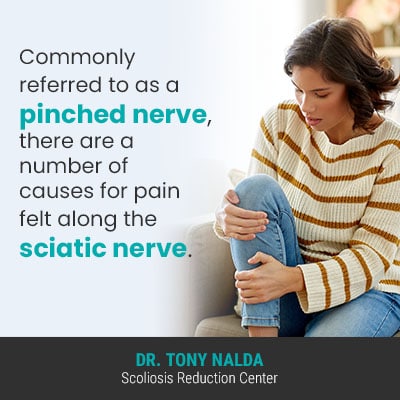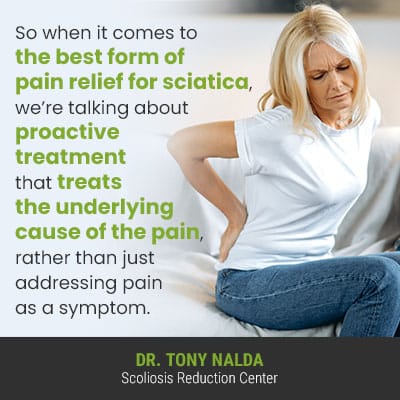The sciatic nerve starts in the lower back and extends down the buttock, leg, and into the foot. If the sciatic nerve is exposed to uneven forces, it can become what’s commonly referred to as a pinched nerve and can produce a wide range of symptoms.
Sciatica involves a pinched spinal nerve in the lower back, causing pain felt at the nerve’s root, or anywhere along its extensive pathway. The most effective pain relief for sciatica is proactive treatment driven by the condition’s underlying cause.
The Sciatic Nerve
The sciatic nerve is the longest and largest nerve in the body, originating in the lumbar spine (lower back) and extending down the buttock, leg, and foot.
The sciatic nerve is also considered a mixed nerve as it contains motor and sensory fibers, meaning it’s involved in both movement and sensation.
The sciatic nerve facilitates most of the functions of the lower body, making movements such as running, walking, and climbing possible.
Sciatica
Nerves need space in which to function optimally, and if a nerve gets exposed to uneven pressure, it can become compressed, irritated, inflamed, and/or impinged, and this can cause a wide range of symptoms, especially in mixed nerves with multiple functions.
Sciatica refers to pain felt anywhere along the sciatic nerve’s pathway, which is extensive, so what types of things can cause this?

Commonly referred to as a pinched nerve, there are a number of causes for pain felt along the sciatic nerve.
Also, keep in mind that nerves fan off from their roots in multiple directions, like branches of a tree, which is why sciatic nerve pain can be felt at the nerve root, or throughout the lower body.
Sciatica most commonly affects the left side of the body, less often, the right side, and although atypical, it can affect both sides.
So what exactly does sciatic nerve pain feel like?
Sciatic Nerve Pain
Sciatic nerve pain can range from mild, with intermittent flare-ups, to chronic and debilitating.
Many regard nerve-related back pain as the worst form, and while some cases of mild sciatica can resolve on their own in a matter of weeks, those that are more severe will require effective treatment that includes pain management.
While each case is unique, sciatic nerve pain can involve:
- Pain in the lower back
- Pain in the buttock
- Pain felt down the back of a leg
- Numbness felt in the lower back
- Numbness in the buttock
- Numbness in the leg and/or foot
- Loss of movement
- Pain that increases with movement
- Sensation of pins and needles in the legs, toes, or feet
- Electric-like shooting pain
- Muscle weakness
- When cauda equina syndrome is the cause, loss of bowel/bladder function
Common Causes of Sciatic Nerve Pain
A pinched nerve develops when it’s exposed to some type of uneven force, meaning pressure.
When the sciatic nerve is pinched due to a loss of space to function within, or is squeezed in some way, this is what causes pain and discomfort, and while there are numerous causes, some of the most common include intervertebral disc issues, spinal lumbar stenosis, and spondylolisthesis.
Intervertebral Disc Issues
The spine’s intervertebral discs are essential to its overall health and function and sit between adjacent vertebrae (bones of the spine).
A healthy spine can maintain its natural curves and alignment to function optimally, and the intervertebral discs are a big part of that.
The discs, as they are made of a soft gel-like inner nucleus and a tough outer annulus, provide the spine with structure by acting as ligaments that hold the vertebrae together by attaching to vertebral end plates.
They also combine forces to facilitate spinal flexibility, range of motion, and act as the spine’s shock absorbers.
When disc issues develop, they can disrupt the position of adjacent vertebrae and introduce uneven forces to the spine.
Degenerative disc disease involves natural age-related deterioration, and the intervertebral discs tend to be the first spinal structures to experience degenerative changes.
This can involve disc desiccation, when a disc experiences significant fluid loss and changes shape as a result, and/or disc herniation.
When a disc herniates, this means its inner nucleus has pushed its way through a tear in the outer annulus, intruding on space within the spinal canal containing nerves within.
If a disc herniates in the lower back (the most common location), it can cause the sciatic nerve to become pinched, irritated, and painful.
The lumbar spine not only has to support the weight of the spinal sections above and the weight of the trunk, it also feels the effects of lifting, bending, and twisting motions.
Lumbar Spinal Stenosis
Lumbar spinal stenosis is a spinal condition that involves a narrowing of space within the spine, putting pressure on the nerves within.
Lumbar spinal stenosis can involve any spinal section – cervical, thoracic, or lumbar – but is most common in the cervical (neck) and lumbar spinal sections (lower back).
If the stenosis involves the lumbar spine, it can impinge the sciatic nerve, causing related pain and discomfort; it’s most commonly caused by general spinal degeneration.
Lumbar Spondylolisthesis
Spondylolisthesis is a spinal-instability issue involving a vertebral body slipping forward and onto the one below. When this happens in the lumbar spine, this can narrow the opening through which the sciatic nerve branches out to different areas of the body, and the bony protrusion of slipped vertebra can pinch the sciatic nerve.
Spondylolisthesis can be caused by disc degeneration, genetics, and spinal trauma.
So if a person is experiencing sciatic nerve pain, what is the most effective pain relief option for sciatica?
Effective Pain Relief for Sciatica
Again, while some cases are mild, likely caused by a recent strain or overuse injury, and can resolve on their own, those with more complex underlying causes may require proactive treatment shaped by the condition’s causation.

So when it comes to the best form of pain relief for sciatica, we’re talking about proactive treatment that treats the underlying cause of the pain, rather than just addressing pain as a symptom.
Scoliosis Reduction Center® Treatment
Here at the Scoliosis Reduction Center®, I feel there’s a big difference between solely treating a patient’s pain, or treatment that targets the underlying cause of the pain. The former will provide short-term pain relief, while the latter, when successful, offers long-term effective and sustainable pain relief for sciatic nerve pain.
By integrating different treatment disciplines such as condition-specific chiropractic care and a variety of physical therapy exercises and stretches, I help patients work towards taking pressure off the sciatic nerve and creating more space for it to function optimally within the spine.
While there are no treatment guarantees, I can work towards restoring disc health and function alongside any related vertebral subluxation.
By adjusting vertebrae so they are in alignment with the rest of the spine, not only does this improve the spine’s overall health and function, it also means reducing the uneven forces contributing to the pinched sciatic nerve.
Physical therapy stretches and exercises, when combined with chiropractic care, are an excellent way to keep the spine and its surrounding muscles as strong and flexible as possible, and a stronger core means better spinal support/stabilization.
Stretches can help with pain relief by taking pressure off the sciatic nerve, as well as augmenting the potential for chiropractic care to help stretch the affected area, and there is more space for the nerve to function within.
Conclusion
When it comes to the most effective pain relief for sciatica, we’re talking about proactive treatment that involves customizing treatment plans around important patient/condition characteristics such as age, symptom severity, and causation.
While there are multiple causative sources associated with sciatica, some common ones are natural age-related spinal degeneration, intervertebral disc issues such as disc desiccation or herniation, and spinal conditions such as lumbar stenosis and lumbar spondylolisthesis.
While short-term and immediate relief can be provided by prescription pain medications and/or lumbar epidural steroid injections for reducing inflammation, these are not the most effective in terms of long-term sustainable pain relief for sciatica.
Here at the Scoliosis Reduction Center®, once the underlying cause of a patient’s sciatic nerve pain is determined, I craft a treatment plan that can impact the condition on multiple levels by combining multiple forms of treatment.
By combining chiropractic care and a variety of physical therapy exercises and stretches, vertebral subluxations that could be contributing to, or resulting from, the cause of sciatica, may be proactively addressed with chiropractic adjustments and augmented by increasing core/spinal strength and flexibility.





